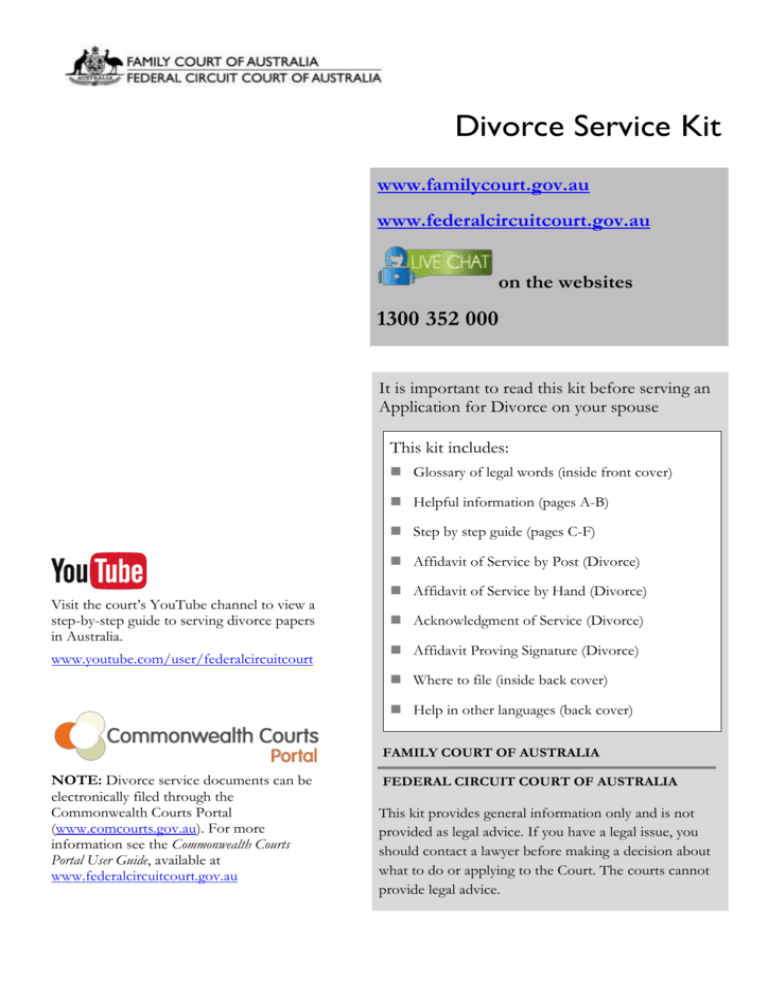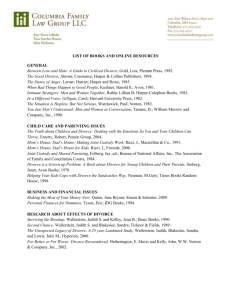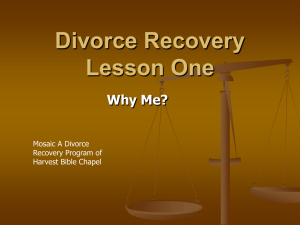Divorce Service Kit - Family Court of Australia
advertisement

Divorce Service Kit www.familycourt.gov.au www.federalcircuitcourt.gov.au on the websites 1300 352 000 It is important to read this kit before serving an Application for Divorce on your spouse This kit includes: Glossary of legal words (inside front cover) Helpful information (pages A-B) Step by step guide (pages C-F) Affidavit of Service by Post (Divorce) Visit the court’s YouTube channel to view a step-by-step guide to serving divorce papers in Australia. www.youtube.com/user/federalcircuitcourt Affidavit of Service by Hand (Divorce) Acknowledgment of Service (Divorce) Affidavit Proving Signature (Divorce) Where to file (inside back cover) Help in other languages (back cover) FAMILY COURT OF AUSTRALIA NOTE: Divorce service documents can be electronically filed through the Commonwealth Courts Portal (www.comcourts.gov.au). For more information see the Commonwealth Courts Portal User Guide, available at www.federalcircuitcourt.gov.au FEDERAL CIRCUIT COURT OF AUSTRALIA This kit provides general information only and is not provided as legal advice. If you have a legal issue, you should contact a lawyer before making a decision about what to do or applying to the Court. The courts cannot provide legal advice. Legal words used in court Address for service – the address given by a party where documents can be served on them by hand, post or certain circumstances, by fax or email. Adjourn – defer or postpone a court event to another day. Affidavit – a written statement by a party or witness. It is the main way of presenting the facts of a case to the Court. An affidavit must be sworn or affirmed before a person who is authorised to witness affidavits; for example, a lawyer or Justice of the Peace. Applicant – the person who applies to the Court for orders. Court hearing – the date and time when a case is scheduled to come before the Court. Dispensation of service – a court order that excuses you from serving court documents on a party. Divorce order – an order made by the Court that ends a marriage. The divorce order becomes final one month and one day after it is made, unless it is shortened by order of the Court. A copy of the divorce order will be made available to you, either by post or through the Commonwealth Courts Portal (if you are a registered user) after the order has become final. eFiling – the procedure of lodging a document through the Commonwealth Courts Portal Family Law Act 1975 – the law in Australia which covers family law matters. Family law registry – a public area at the courts where people can obtain information about the court process and where parties file documents in relation to their case. Family violence – means violent, threatening or other behaviour by a person that coerces or controls a member of the person’s family (the family member), or causes the family member to be fearful. A child is exposed to family violence if the child sees or hears family violence or is otherwise exposed to family violence. See the Family Law Act, section 4AB, which gives examples. Family violence may also amount to abuse of a child. Abuse - in relation to a child means, (a) an assault, including a sexual assault, of the child; or (b) a person (the first person) involving the child in a sexual activity with the first person or another person in which the child is used, directly or indirectly, as a sexual object by the first person or the other person, and where there is an unequal power in the relationship between the child and the first person; or (c) causing the child to suffer serious psychological harm, including (but not limited to) when that harm is caused by the child being subjected to, or exposed to, family violence; or (d) serious neglect of the child. Family violence order – an order made under Commonwealth, state or territory legislation to protect a person, including a child, from violence. Filing – the procedure of lodging a document at a family law registry. Judicial officer – a person who has been appointed to hear and decide cases; for instance, a judge. Party or parties – a person or people involved in a court case; for example, the applicant and/or respondent. Registrar – a court lawyer who has been delegated power to perform certain tasks; for example, grant divorces, sign consent orders and decide the next step in a case. Respondent – a person named as a party to a case. A respondent may or may not respond to the orders sought by the applicant. Rules – a set of directions that outlines court procedures and guidelines. Sealed copy – a copy of a document which has the original court seal stamped on it. Service – the process of delivering or posting court documents to a party after they have been filed, in accordance with the rules of court. Service ensures that all parties have received the documents filed with the Court. Spouse – husband or wife. Legal advice You should seek legal advice before deciding what to do. A lawyer can help you understand your legal rights and responsibilities, and explain how the law applies to your case. You can seek legal advice from a legal aid office, community legal centre or private law firm. Court staff can help you with questions about court forms and the court process, but cannot give you legal advice. What you need to know WHAT IS SERVICE? Service is the process of delivering or posting court documents to a party after they have been filed, in accordance with the rules of court. Service ensures that all parties have received the documents filed with the Court. SHOULD YOU SERVE YOUR APPLICATION? If you have made a sole application, you must arrange to serve the following documents on your spouse: a sealed copy of the Application for Divorce a copy of the Marriage, Families and Separation brochure, and any other documents filed with the Court, except the copy of your marriage certificate. If you have made a joint application, you do not need to serve your spouse with any documents. TIME LIMITS If your spouse is in Australia, the documents must be served at least 28 days before the court hearing. If your spouse is overseas, the documents must be served at least 42 days before the court hearing. HOW CAN YOU SERVE DOCUMENTS? You can serve the documents on your spouse in two ways: 1. Service by Post You should only attempt service by post if you are confident your spouse will return the Acknowledgment of Service (Divorce) to you. Without this, the Court cannot be sure your spouse has received the documents. If you attempt service by post and do not receive the signed Acknowledgment of Service (Divorce), you may need to arrange service by hand. 2. Service by Hand You cannot serve the documents on your spouse yourself. You must arrange for a person over 18 to serve the documents on your spouse (the server). The server can be a family member, friend or professional process server. FILING THE SERVICE DOCUMENTS After the documents have been served on your spouse, you will need to file the service forms with the court electronically (eFile) through the Commonwealth Courts Portal (www.comcourts.gov.au ) or make a photocopy and file the original and the copy by posting them to the family law registry where the Application for Divorce was filed. A SERVING YOUR SPOUSE’S LAWYER If your spouse has a lawyer and he or she is willing to accept service, you can serve the documents on your spouse’s lawyer. A signed and dated Acknowledgment of Service (Divorce) from your spouse’s lawyer is proof of service. You need to file this acknowledgment with the Court. If it has been properly completed you do not need to file any other service documents. WHAT IF YOU CANNOT SERVE YOUR SPOUSE? If you are having trouble serving the divorce application on your spouse, and have taken all reasonable steps to serve your spouse, you can apply to the Court for: substituted service, or dispensation of service. The legal issues about substituted service and dispensation of service are complex. You should seek legal advice. For more information, see the fact sheet ‘Are you having trouble serving your divorce application?’. You can get this fact sheet from www.federalcircuitcourt.gov.au ELECTRONIC FILING OF APPLICATIONS FOR DIVORCE NOTE: Divorce service documents can be electronically filed through the Commonwealth Courts Portal (www.comcourts.gov.au). For more information see the Commonwealth Courts Portal User Guide, available at www.federalcircuitcourt.gov.au B Step by step guide This step by step guide explains how to serve your Application for Divorce and how to complete the service forms. This guide only applies if you have made a sole application. It does not apply if you have made a joint application. Once your divorce application has been filed at a family law registry, it must be served on your spouse. You need to decide which way to serve your application; by post or by hand. There are different steps to follow for each type of service. SERVICE BY POST STEP 1 Obtain service forms You need the following forms: Affidavit of Service by Post (Divorce), and Acknowledgment of Service (Divorce). These forms are in this Kit. You can also get these forms from www.federalcircuitcourt.gov.au STEP 2 Post documents to your spouse You need to post to your spouse at his or her last known address: a sealed copy of the Application for Divorce and any other documents you have filed with the Court, except the copy of your marriage certificate the Marriage, Families and Separation brochure an Acknowledgment of Service (Divorce) a letter asking your spouse to sign the Acknowledgment of Service (Divorce) and return it to you, and a stamped self-addressed envelope for the return of the signed Acknowledgment of Service (Divorce). Helpful hint – remember to record the date you posted the documents to your spouse. STEP 3 The signed Acknowledgment of Service (Divorce) is returned to you If this document is not returned to you, you may need to serve your divorce application by hand. STEP 4 Complete the Affidavit of Service by Post (Divorce) You must answer all questions on the Affidavit of Service by Post (Divorce), including question 6 which confirms that your spouse has signed the Acknowledgment of Service (Divorce). Attach the signed Acknowledgment of Service (Divorce) to the Affidavit of Service by Post (Divorce). C STEP 5 Sign the Affidavit of Service by Post (Divorce) You need to swear or affirm the Affidavit of Service by Post (Divorce) before a person who is authorised to witness affidavits; for example, a lawyer or Justice of the Peace. The person witnessing the Affidavit of Service by Post (Divorce) must also complete the annexure note on the Acknowledgment of Service (Divorce). STEP 6 Make a photocopy of the service forms You will need to make a photocopy of the completed service forms before filing them at a family law registry. STEP 7 File service forms at court You need to file the following prior to the hearing date: Affidavit of Service by Post (Divorce), and Acknowledgement of Service (Divorce) You can eFile using the Commonwealth Courts Portal (www.comcourts.gov.au) or if you are filing at a family law registry you will need to file the originals and a photocopy of each form listed above. Helpful hint – If you are attending the court hearing, take your copy of the service forms with you. SERVICE BY HAND STEP 1 Obtain service forms You need the following forms: Affidavit of Service by Hand (Divorce) Acknowledgment of Service (Divorce), and Affidavit Proving Signature (Divorce). These forms are in this Kit. You can also get these forms from www.federalcircuitcourt.gov.au. STEP 2 Choose a person to serve the documents You cannot serve the documents on your spouse yourself. You must arrange for a person over 18 to serve the documents on your spouse (the server). The server can be a family member, friend or professional process server. To find a professional process server, look in the Yellow Pages (fees apply). D STEP 3 Give documents to the server You need to give the following documents to the server: a sealed copy of the Application for Divorce and any other documents you have filed with the Court, except the copy of your marriage certificate the Marriage, Families and Separation brochure, and an Acknowledgment of Service (Divorce). STEP 4 Serving the documents The server hands the documents to your spouse. The server must identify your spouse so the Court knows that the documents have been given to the right person. If the server is a family member or friend who knows your spouse, this is enough proof of identity. If the server does not know your spouse, then they must identify him or her. The server can identify your spouse by: a photograph asking questions; for example, ‘What is your full name?’ or ‘Are you the husband/wife of [state name of applicant]?’, or having another person present at the time of service who knows your spouse. STEP 5 The server asks your spouse to sign the Acknowledgment of Service (Divorce) If your spouse accepts the documents, the server must ask him or her to sign the Acknowledgment of Service (Divorce). If your spouse refuses to accept the documents, the server can put them down in the presence of your spouse and state what they are. For example, ‘Your spouse is applying for a divorce and I am serving you with the divorce application. The divorce application is listed for hearing on [state date] at [state court location]’. STEP 6 Server signs the Affidavit of Service by Hand (Divorce) The server must include any information or attach any documents to the Affidavit of Service by Hand (Divorce) which helped him or her identify your spouse. If the server identified your spouse with a photograph, you should also prepare a further brief affidavit stating that the person in the photograph is your spouse. The server must then swear or affirm the Affidavit of Service by Hand (Divorce) before a person who is authorised to witness affidavits; for example, a lawyer or Justice of the Peace. If your spouse signed the Acknowledgment of Service (Divorce), it must be attached to the Affidavit of Service by Hand (Divorce). The witness is also required to complete the annexure note at the bottom of the Acknowledgment of Service (Divorce). Note: Question 3 – Date of documents served must be completed. STEP 7 Sign the Affidavit Proving Signature (Divorce) If your spouse signed the Acknowledgment of Service (Divorce) and you recognise their signature, you should complete the Affidavit Proving Signature (Divorce). You will need to swear or affirm the Affidavit Proving Signature (Divorce) before a person who is authorised to witness affidavits; for example, a lawyer or Justice of the Peace. Attach a copy of the signed Acknowledgment of Service (Divorce) to the Affidavit Proving Signature (Divorce). E STEP 8 Make a photocopy of the service forms You will need to make a photocopy of the completed service forms before filing them at a family law registry. STEP 9 File the service forms at court You need to file the following prior to the hearing date: Affidavit of Service by Hand (Divorce) Acknowledgement of Service (Divorce), and Affidavit Proving Signature (Divorce) You can eFile using the Commonwealth Courts Portal (www.comcourts.gov.au) or if you are filing at a family law registry you will need to file the originals and a photocopy of each form listed above. Helpful hint – If you are attending the court hearing, take your copy of the service forms with you. The courts and your privacy The courts respect your right to privacy and the security of your information. You can read more about the courts’ commitments and legal obligations in the fact sheet ‘The courts and your privacy’. The fact sheet includes details about information protection under the privacy laws and where privacy laws do not apply. F AFFIDAVIT OF SERVICE BY POST (DIVORCE) Filed in: Federal Circuit Court of Australia Family Court of Australia Family Court of Western Australia Other (specify): Client ID You must attach the signed Acknowledgment of Service (Divorce) to this form. Filed on File number COURT USE ONLY Filed at Court location Court date Court time Part A The applicant 1. Family name Given names Name Part B Details of service 2. Person served (respondent) Family name Given names 3. Postal address of respondent State 4. Date of posting 5. What documents were posted? Postcode / / Application for Divorce Marriage, Families & Separation brochure Other (give details): 6. Acknowledgment The Acknowledgment of Service (Divorce) is signed by the person named in of Service signed question 2 above. It is attached to this affidavit. Part C Signing Do not swear/affirm this affidavit until you are with a person who is authorised to witness your signature. I swear / affirm that: 1. I am the applicant. 2. The person served is my spouse (respondent). 3. The facts set out are true. 4. I recognise the signature on the Acknowledgment of Service (Divorce) as that of my spouse. Signature Place Date Before me (signature of witness) Full name of witness (print name) Lawyer Justice of the Peace Other (specify): / / Authorised Staff Member of the Court The witness must also sign the annexure note on the Acknowledgment of Service (Divorce). 0313 V2 1 AFFIDAVIT OF SERVICE BY HAND (DIVORCE) Filed in: Federal Circuit Court of Australia Family Court of Australia Family Court of Western Australia Other (specify): Client ID The applicant cannot serve the respondent. If the respondent signed the Acknowledgment of Service (Divorce), it must be attached to this form. Filed on File number COURT USE ONLY Filed at Court location Court date Court time Part A Person serving documents 1. Name Family name Given names 2. Address State 3. Postcode Occupation Part B Details of service 4. Person served (respondent) Family name Given names 5. Date documents served / / 6. What documents were served? Application for Divorce Marriage, Families & Separation brochure Other (give details): 7. How were the documents served? I handed them to the person at (give address): I attempted to hand them to the person at (give address): The person refused to accept them. I put them down and left them in the presence of the person and told the person what they were. 1 Part C Identity of person served 8. How was the person served identified? I know the person The person is shown in the attached photograph I saw the person sign the attached Acknowledgment of Service (Divorce) I spoke to the person at the time of service (give details of conversation relating to identity): Part D Signing Do not swear/affirm this affidavit until you are with a person who is authorised to witness your signature. I swear / affirm that: 1. I am the server. 2. The facts set out are true. Signature Place Date Before me (signature of witness) Full name of witness (print name) / / Lawyer Justice of the Peace Authorised Staff Member of the Court Other (specify): The witness must also sign the annexure note on the Acknowledgment of Service (Divorce). 0313 V2 2 ACKNOWLEDGMENT OF SERVICE (DIVORCE) Filed in: Federal Circuit Court of Australia Family Court of Australia Family Court of Western Australia Other (specify): Client ID This form must be attached to EITHER: an Affidavit of Service by Post (Divorce) OR both an Affidavit of Service by Hand (Divorce) and Affidavit Proving Signature (Divorce). Filed on File number COURT USE ONLY Filed at Court location Court date Court time Part A The applicant 1. Family name Given names Name Part B Details of service 2. Person served (respondent) Family name Given names 3. Date documents served / 4. What documents were served? Part C / Application for Divorce Marriage, Families & Separation brochure Other (give details): Signing I acknowledge service of the documents named in question 4 above. Signature Date / / OR I am the lawyer for the person served. On behalf of my client, I acknowledge service of the documents named in question 4 above. Lawyer’s signature Date / / Name of lawyer (print name): Lawyer’s code: Address of lawyer: ANNEXURE NOTE — Witness to complete only if this form is attached to an affidavit. This Acknowledgment of Service (Divorce) is referred to in the affidavit of (name): Sworn/affirmed at (place): On (date): Before me (witness to sign): Lawyer Justice of the Peace Authorised Staff Member of the Court Other (specify): 0313 V2 1 AFFIDAVIT PROVING SIGNATURE (DIVORCE) Client ID Filed in: Federal Circuit Court of Australia Family Court of Australia Family Court of Western Australia Other (specify): File number COURT USE ONLY Filed at Filed on You must attach the signed Acknowledgment of Service (Divorce) to this form. Court location Court date Court time Part A The applicant 1. Family name Given names Name Part B 2. Identifying signature Acknowledgment The attached Acknowledgment of Service (Divorce) is signed by: of service signed Family name (respondent) Given names Part C Signing Do not swear/affirm this affidavit until you are with a person who is authorised to witness your signature. I swear / affirm that: 1. The facts set out are true. 2. I recognise the signature on the Acknowledgment of Service (Divorce) as that of my spouse. Signature Place Date Before me (signature of witness) Full name of witness (print name) / / Lawyer Justice of the Peace Authorised Staff Member of the Court Other (specify): The witness must sight the signature of the person served on the Acknowledgment of Service (Divorce). 0313 V2 1 Where to file your divorce service forms You can file your divorce service forms, online via www.comcourts.gov.au, in person or by post, at any one of the following family law registries. AUSTRALIAN CAPITAL TERRITORY Canberra (Nigel Bowen Commonwealth Law Courts Cnr University Ave and Childers St Canberra ACT 2600 GPO Box 9991 Canberra ACT 2601 NEW SOUTH WALES Albury Level 1, 463 Kiewa St Albury NSW 2640 PO Box 914 Albury NSW 2640 Dubbo Cnr Macquarie and Wingewarra Sts Dubbo NSW 2830 PO Box 1567 Dubbo NSW 2830 Lismore Level 2, 29–31 Molesworth St Lismore NSW 2480 PO Box 9 Lismore NSW 2480 Newcastle 61 Bolton St Newcastle NSW 2300 PO Box 9991 Newcastle NSW 2300 Parramatta 1–3 George St Parramatta NSW 2123 PO Box 9991 Parramatta NSW 2123 Sydney (Lionel Bowen Commonwealth Law Courts) 97–99 Goulburn St Sydney NSW 2000 GPO Box 9991 Sydney NSW 2001 Wollongong Level 1, 43 Burelli St, Wollongong NSW 2500 PO Box 825 Wollongong NSW 2500 NORTHERN TERRITORY Alice Springs Westpoint Building Cnr Railway Terrace and Stott Terrace Alice Springs NT 0870 PO Box 9991 Alice Springs NT 0871 Darwin Supreme Court Building, State Square, Darwin NT 0800 GPO Box 9991 Darwin NT 0800 QUEENSLAND Brisbane (Harry Gibbs Commonwealth Law Courts) 119 North Quay Brisbane QLD 4000 PO Box 9991 Brisbane QLD 4001 Cairns Level 3 and 4, 104 Grafton St Cairns QLD 4870 PO Box 9991 Cairns QLD 4870 Rockhampton 46 East St (Cnr Fitzroy St) Rockhampton QLD 4700 PO Box 9991 Rockhampton QLD 4700 Townsville Level 2, Commonwealth Centre, 143 Walker St Townsville QLD 4810 PO Box 9991 Townsville QLD 4810 SOUTH AUSTRALIA Adelaide (Roma Mitchell Commonwealth Law Courts) 3 Angas St Adelaide SA 5000 GPO Box 9991 Adelaide SA 5001 TASMANIA Hobart (Edward Braddon Commonwealth Law Courts) 39–41 Davey St Hobart Tas 7000 GPO Box 9991 Hobart Tas 7001 Launceston Level 3, ANZ Building, Cnr Brisbane & George Sts Launceston Tas 7250 PO Box 9991 Launceston Tas 7250 VICTORIA Dandenong 53–55 Robinson St Dandenong Vic 3175 PO Box 9991 Dandenong Vic 3175 Melbourne (Owen Dixon Commonwealth Law Courts 305 William St Melbourne Vic 3000 GPO Box 9991 Melbourne Vic 3001 WESTERN AUSTRALIA Perth Family Court of Western Australia 150 Terrace Rd Perth WA 6000 GPO Box 9991 Perth WA 6848 08 9224 8222 Help in other languages If you need to contact the courts, call the Translating and Interpreting Service on 13 14 50. This is a free service. If you need an interpreter to assist you at court, please tell court staff at least one week before your court appointment or hearing. Court staff will arrange a professional and independent interpreter to assist you free of charge. KITDIVSER_0313V2








